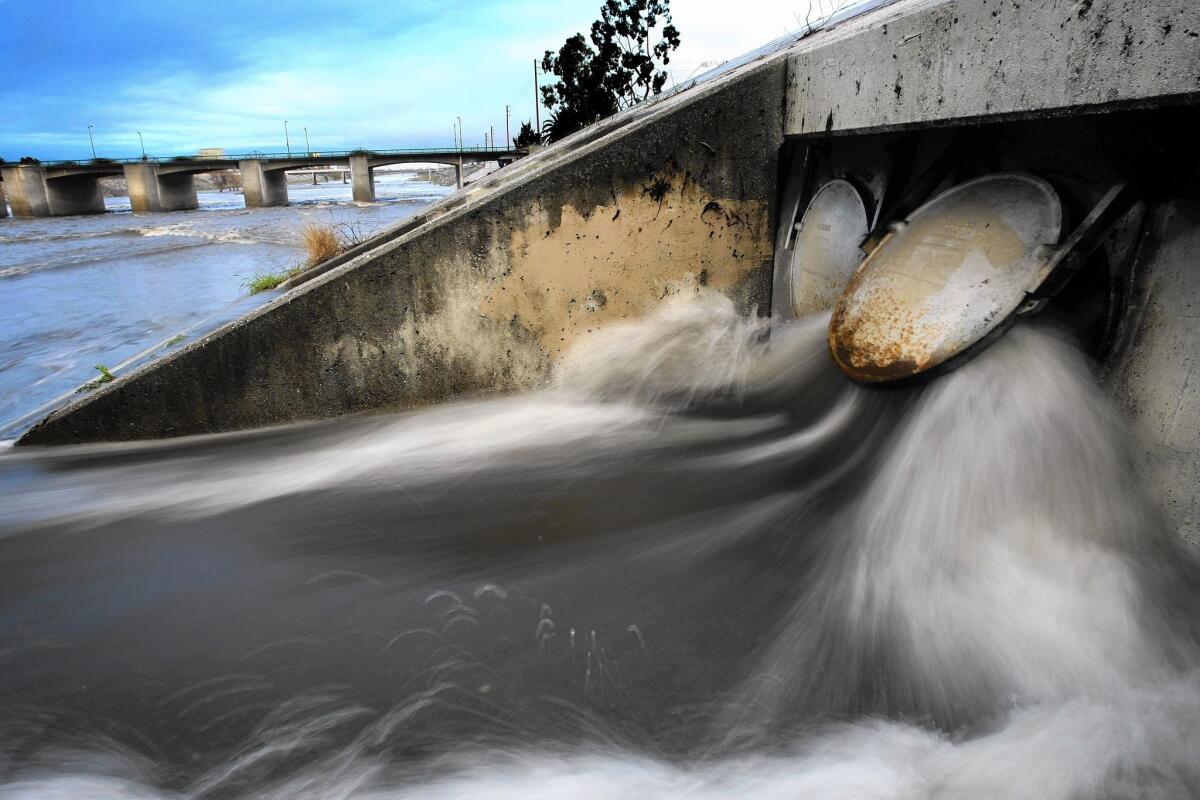DWP to unveil plan to capture storm runoff

Stormwater gushes into the L.A. River; Los Angeles collects an average of 27,000 acre-feet of rainwater each year, and efforts are underway to greatly increase that amount.
- Share via
It may not rain much in Los Angeles County, but when it does, a single storm can send up to 10 billion gallons of water surging into a vast network of storm channels with a single destination: the Pacific Ocean.
For decades, environmental activists such as Andy Lipkis have argued that this ritual flushing of stormwater was a form of profligacy Los Angeles could ill afford. That water could be captured before it picked up ground contaminants and used for irrigation and other purposes.
Yet when the president and founder of TreePeople began proposing more than 20 years ago that the city “harvest” rainwater from the sky, the response was always the same.
“They asked me what planet I was from. What was I smoking?” Lipkis said with a laugh.
Today, however, attitudes are very different. After four years of drought, unprecedented restrictions on urban water use and steady increases in the cost of imported water, officials in Los Angeles and other cities are now looking at stormwater runoff as more than just a flood risk.
At a public hearing Thursday, the Los Angeles Department of Water and Power will present its Stormwater Capture Master Plan, an initiative that officials say will reduce the city’s future reliance on imported water and perhaps address a predicted trend toward heavier, more intense rainfall.
The plan includes three large-scale projects in the San Fernando Valley that would collect rainfall in basins or washes and then slowly feed it into the city’s primary underground water source — a process known as aquifer recharge.
The proposal also lists a variety of smaller features that would be located on public, private and commercial properties throughout the city: Water-permeable surfaces that would help recharge the San Fernando Valley groundwater basin, as well as redesigned “green streets” and pocket parks.
Incentive programs would be used to encourage homeowners, schools or businesses to install large cisterns, or create so-called rain gardens and swales that would help clean stormwater runoff and direct it to landscaping or capture basins.
Currently, the city collects an average of 27,000 acre-feet of rainwater each year. That water is captured in flood control dams and spreading grounds, where it is allowed to filter into the aquifer.
Under the Stormwater Capture Master Plan, the city could collect 100,000 to 200,000 additional acre-feet of rainwater each year by 2035, depending on how aggressively it pursued the plan, officials say. One acre-foot of water is equal to 326,000 gallons, or about enough to supply two households with water for a year.
According to the DWP, the plan would cost $600 to $1,100 for each acre-foot of additional stormwater captured — or $60 million to $220 million, depending on what elements were implemented.
David Pettijohn, director of water resources at DWP, said the department does not envision funding the entire cost of the master plan proposal.
Projects within the plan would be approved on a case-by-case basis by the department’s board of directors, and the DWP would seek funding help from other agencies, such as the Los Angeles County of Department of Public Works, which would also have to approve the projects.
“We rarely do these projects by ourselves without other parties helping us to fund them,” Pettijohn said.
At least one vocal critic of the DWP has questioned how that expense will be divided. Jack Humphreville, a member of the Greater Wilshire Neighborhood Council, has written that he fears DWP ratepayers will be saddled with most of the cost.
The stormwater plan has been in the works for two years and is part of a larger initiative that includes water conservation, recycled water and cleanup of the Valley aquifer. Although the aquifer amounts to an enormous underground reservoir, it contains zones of chemical contamination that limit its use.
“We need to get that groundwater basin cleaned up,” Pettijohn said. “That’s kind of a foundational action for our stormwater capture program.”
TreePeople has been advising the DWP, and has funded several test projects in the lead-up to the planning process.
Lipkis said he believes widespread development of decentralized projects will result in more stormwater capture than DWP officials anticipate. Large cisterns that hold thousands of gallons of rainwater should be installed in residential properties throughout the city with government help, he said.
He said that in Australia, more than a quarter of the residents in many cities installed large cisterns due to drought and aggressive investment of incentives.
In an average year, Los Angeles receives about 15 inches of rain.
Prior to urbanization, much of this precipitation would soak into the earth and make its way to underground aquifers. Now, impenetrable surfaces such as streets, sidewalks, rooftops and parking lots prevent this.
As a result, runoff flows into the ocean, carrying animal waste, trash, metals, automotive oils and other contaminants.
Researchers argue that because of climate change, Southern California and other regions will eventually experience fewer episodes of rainfall, but that storms will occur with greater intensity and generate even more runoff.
“We do have facilities in place that can catch quite a bit of stormwater, but we want to increase that capacity,” Pettijohn said. “Think of it this way. If all the rain fell on a single day, you’d have to build a facility big enough to capture every single drop.”
The final hearing for the Stormwater Capture Master Plan is scheduled for 6 p.m. at DWP Headquarters, at 111 N. Hope St., Los Angeles.
Twitter: @montemorin
More to Read
Sign up for Essential California
The most important California stories and recommendations in your inbox every morning.
You may occasionally receive promotional content from the Los Angeles Times.











